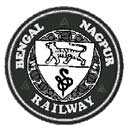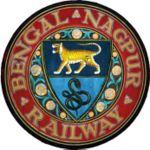Bengal-Nagpur Railway
| Bengal-Nagpur Railway | ||
|---|---|---|
 Bengal-Nagpur Railway device | ||
| Line of route | ||
| Calcutta to Nagpur (Bombay) Calcutta to Waltair (Madras) Bilaspur to Katni | ||
| Gauge / mileage | ||
| Broad gauge | 1696 miles (1905) | |
| Timeline | ||
| 1887 | Company formed | |
| 1888 | Existing metre gauge converted to broad | |
| 1944 | Line acquired by state | |
| Key locations | ||
| Presidency | Bengal | |
| Stations | ||
| System agency | ||
| Worked by Bengal-Nagpur Railway | ||
| How to interpret this infobox | ||
| Bengal-Nagpur Railway | ||
|---|---|---|
 Bengal-Nagpur Railway device | ||
| System timeline | ||
| 1944 | Management of line taken over by state | |
| Constituent companies / lines | ||
| Bengal-Nagpur Railway | ||
| Jubbulpore-Gondia Railway | ||
| Mayurbhanj Railway | ||
| Parlakimedi Light Railway | ||
| Raipur-Dhamtari Railway | ||
| Key locations | ||
| Headquarters | Calcutta | |
| Workshops | Kharagpur | |
| Major Stations | Asansol, Balasore, Bilaspur, Chanda, Chhindwara, Cuttack, Jubbulpore, Mandla, Nagpur, Raipur, Sambalpur, Vizagapattam | |
| Successor system / organisation | ||
| 1952 | Eastern Railway (IR zone) | |
| 1955 | South Eastern Railway (IR zone) | |
| System mileage | ||
| Broad gauge | 1696 miles (1905) 2498 miles (1943) | |
| Narrow (2' 6") gauge | 343 miles (1905) 798 miles (1943) | |
| Associated auxiliary force | ||
| Bengal Nagpur Railway Battalion | ||
| How to interpret this infobox | ||
The Bengal-Nagpur Railway (BNR) was formed in 1887 to take over the metre gauge(MG) Nagpur-Chhattisgarh Railway, to convert the existing metre gauge track to broad gauge(BG) and to extend the system eastwards to join the East Indian Railway at Asansol, 132 miles from Calcutta. [1]
History
The BNR was the last major railway formed to benefit from a Government guarantee, with the system from the outset owned by the Government of India GoI who contracted the BNR company to manage matters, initially for 25 years and therafter determinable every 10 years.
The BNR was the last company to be nationalised, on 1 October 1944. In 1952, the BNR was merged with the East Indian Railway to form Indian Railways' Eastern Railway but in 1955, BNR re-emerged to form South Eastern Railway.
Branch Lines and extensions
- Anuppur-Manendragarb-Chimiri Railway. Opened 1939 by BNR; built primarily to convey coal from the Kotma area
- Cuttack-Midnapore-Calcutta Railway Survey. Surveyed 1899 and absorbed into BNR network, extended by BNR 1901
- Nagbhir-Nagpur Branch Railway. Opened 1908, branch line of BNR Southern Grid. Construction commenced 1905
- Raipur-Dhamtari Railway and Rajim Branch Railway. The first 2ft 6in/762mm narrow gauge(NG) branch of BNR, opened 1900 and extended to Rajim 1906
- Purulia Ranchi Light Railway. Opened 1907 Narrow gauge section of BNR
- Satpura Railway. Developed by the BNR 1902-9; connected Jubbupore with Gondia, Mandla Fort, Chhindwara and Nagpur; later extended. Comprising -
- Gondia-Chanda Railway. Extension of the BNR narrow gauge Satpura Railway network, opened 1908-16
- Gondia-Nainpur-Chhindwara-Jabalpur Railway. Opened 1903-05 as part of Satpura Railway.
- Jubbulpore-Gondia Railway. Opened 1902, owned by GoI; worked by BNR; merged into Satpura Railway, c.1920
- Nainpur-Mandla Fort Railway. Opened 1909; worked by BNR as part of Satpura Railway
Railways absorbed into BNR
- East Coast State Railway. GoI survey 1890; GoI owned; opened 1893-98; N.sections worked and absorbed by BNR;
- Katni-Umaria Provincial State Railway. Opened 1886-87. Previously named Bilaspur-Etawa Provincial State Railway renamed Katni-Umaria Provincial State Railway, c1887; then merged into BNR.
- Nagpur Chhattisgarh Railway. Opened 1880; previously Chhattisgarh State Railway owned by Provincial Government; worked as part of the Indian State Railways; merged into BNR, 1887.
- Nagpur-Chhindwara Railway. Opened 1911, owned by GoI and worked by BNR merged into Satpura Railway, c.1920.
- Umaria Coalfield Railway. Opened 1883 , connected to main line, 1891 as part of Katni-Umaria Provincial State Railway, c1887; then merged into BNR.
Lines worked by BNR at some time
- Baripada-Talbond Railway. Opened 1920, extension to Mayurbhanj Railway; worked by BNR.
- Bellary-Kistna State Railway. Constructed before 1890; surveyed for Hindpur extension 1892-94; worked by BNR.
- Central Indian Coalfields Railway. Opened 1927, GoI owned; part worked by BNR; later amagamated with East Indian Railway(EIR)
- Ganjam District Light Railway. Surveyed 1899 but did not go ahead in entirety; Parlakimedi Light Railway opened 1 section, 1900 worked by BNR from 1902.
- Kamptee-Deolapar-Ramtek Railway; Surveyed 1903 to construct light railway on public roads to convey Manganese; worked by BNR(qv); no further information
- Mayurbhanj Railway; 2ft 6in/762mm narrow gauge(NG); opened 1905, formerly Mourbhanj Railway, renamed 1920 and transferred to private company; worked by BNR.
- Panposh-Ruipura Railway. Opened 1919-20; worked by BNR.
- Parlakimedi Light Railway; 2ft 6in/762mm narrow gauge(NG); opened 1900; private company,owned by Raja of Parlakimedi, worked by BNR.
- Pench Valley Coalfield Railway; opened 1906-7; 2ft 6in/762mm narrow gauge(NG)line, from the Pench and Kanhan coalfields to Chhindwara where it connected to the (BNR) Satpura Railway network; worked by BNR.
- Tumsar-Tirodi Light Railway. Opened 1910 as Tumsar-Katangi Rly owned by Central India Mining Co ; Purchased in 1916-17 by GoI; worked by BNR; connecting to BNR's Satpura Railway.
- Visakhapatnam Port Trust Railway. Inner harbour railway, built by BNR 1927-33 to export manganese ore.
Records
Refer to FIBIS Fact File #4: “Research sources for Indian Railways, 1845-1947” - available from the Fibis shop. This Fact File contains invaluable advice on 'Researching ancestors in the UK records of Indian Railways' with particular reference to the India Office Records (IOR) held at the British Library
An on-line search of the IOR records relating to this railway [2] gives 47 references. The most important being:-
- L/AG/46/5 “Records of the Bengal Nagpur Railway Company; 1856-1947
- L/F/7/249-255 "Finance Department Records; 1890-1947
There are no BNR Staff Agreements in the IOR but as a State Railway a search of the following may yield a result -
- L/F/8/1-20 "Appointments to State Railways made in the UK 1855-1946"
- Z/L/F/8/1-2 Index to Appointments to State Railways made in the UK 1855-1946"
A series of articles on the BNR, then celebrating its (highly significant) 25th year, was published during 1911 in The Indian Railway Gazette. The December 1911 issue carried biographical entries on the top 12 staff complete with individual photographic portraits. Microfilm of the Gazette can be consulted at the British Library's Newsroom.
There are some reports, letters and notes on the railway's history covering 1890-1930 held at
- Hertfordshire Archives and Local Studies, including copies of the Bengal-Nagpur Railway Magazine for July 1929, August 1929, November 1930 and December 1930.
Personnel
- Francis Joseph Edward Spring, 1880-84 deployed from the Railway Branch of the Public Works Department, to the Bengal-Nagpur Railway Survey
- Arthur John Barry Lieutenant Colonel , was an an English civil engineer and architect. Engaged c.1887 as BNR Executive Engineer in charge of the construction of the bridge over the Damuda River bridge and the work of the Damuda district, afterwards Superintending Engineer of the Bengal section.
- Trevredyn Rashleigh Wynne , 1887-1905 deployed from the Railway Branch of the Public Works Department, to the BNR as its first Agent and Chief Engineer.
- Frederick Smith Stanton, 1887-92, following his retirement as Director General of Indian Railways, served on the Board of the Bengal-Nagpur Railway Company, based in London.
- C W Bowles Colonel; date unknown but prior to 1907; BNR Engineer in charge of constructing its workshops, houses, schools, churches, hospitals, armoury, recreational facilities and a gaol. It was during this period that he experimented with using the Ewing System for transporting construction material during the laying of railway tracks for BNR. The Ewing system was subsqently used by Bowles for the Patiala State Monorail Trainways
External Links
- Evolution of SER over the years A history of the South Eastern Railway, including the BNR and its constituents. This archived link from South Eastern Railway is most likely chapters (or content) from the book South Eastern Railway: March to New Millennium 1878-2001 by R. R. Bhandari 2001. Unfortunately, not all the chapters are accessible.
- Kharagpur’s Diaspora Reunited Memories and photos of a BNR family, the Cramptons, from the 1930s to 1950s.
- A map on which the Bengal-Nagpur Railway is shown may be found in Correspondence Part 7 (scroll down a considerable way)
- "Indian Railway Notes" by Hugh Scholey
References
- ↑ " Administration Report on the Railways in India – corrected up to 31st March 1918"; Superintendent of Government Printing, Calcutta; pages 1 to 5; Retrieved 19 Feb 2016
- ↑ British Library Archives & Manuscripts Catalogue; Retrieved 18 Jan 2016